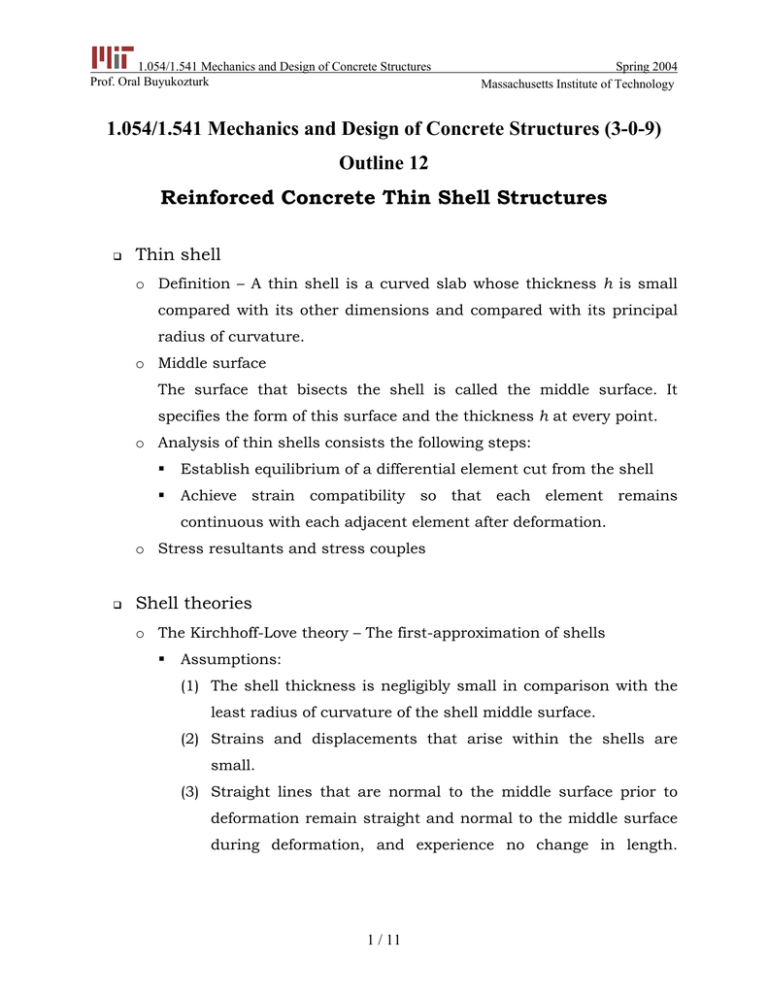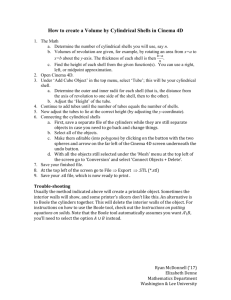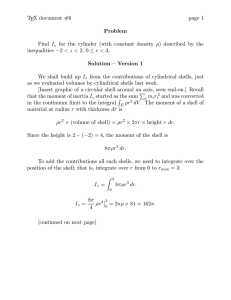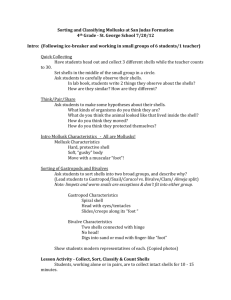1.054/1.541 Mechanics and Design of Concrete Structures Spring 2004 Prof. Oral Buyukozturk
advertisement

1.054/1.541 Mechanics and Design of Concrete Structures
Prof. Oral Buyukozturk
Spring 2004
Outline 12
Massachusetts Institute of Technology
1.054/1.541 Mechanics and Design of Concrete Structures (3-0-9)
Outline 12
Reinforced Concrete Thin Shell Structures
Thin shell
o Definition – A thin shell is a curved slab whose thickness h is small
compared with its other dimensions and compared with its principal
radius of curvature.
o Middle surface
The surface that bisects the shell is called the middle surface. It
specifies the form of this surface and the thickness h at every point.
o Analysis of thin shells consists the following steps:
Establish equilibrium of a differential element cut from the shell
Achieve strain compatibility so that each element remains
continuous with each adjacent element after deformation.
o Stress resultants and stress couples
Shell theories
o The Kirchhoff-Love theory – The first-approximation of shells
Assumptions:
(1) The shell thickness is negligibly small in comparison with the
least radius of curvature of the shell middle surface.
(2) Strains and displacements that arise within the shells are
small.
(3) Straight lines that are normal to the middle surface prior to
deformation remain straight and normal to the middle surface
during deformation, and experience no change in length.
1 / 11
1.054/1.541 Mechanics and Design of Concrete Structures
Prof. Oral Buyukozturk
Spring 2004
Outline 12
(Analogous to Navier’s hypothesis for beams – Bernoulli-Euler
theory for beams)
(4) The direct stress acting in the direction normal to the shell
middle surface is negligible.
Results of the assumptions:
–
Normal directions to the reference surface remain straight and
normal to the deformed reference surface.
–
The hypothesis precludes any transverse-shear strain, i.e., no
change in the right angle between the normal and any line in
the surface.
–
It is strictly applicable to thin shells.
–
It is not descriptive of the behavior near localized loads or
junctions. (Assumption (4) is not valid in the vicinity of
concentrated transverse loads.)
o The Flügge-Byrne theory – The second-approximation of shells
Assumptions:
–
It adopts only assumption (2).
–
It is referred to as “higher-order approximations” of the
Kirchhoff-Love assumptions
Classification of shells:
o Classified by governing equation of geometry:
Paraboloid of revolution
Hyperboloid of revolution
Circular cylinder
Elliptic paraboloid
Hyperbolic paraboloid
Circular cone
2 / 11
1.054/1.541 Mechanics and Design of Concrete Structures
Prof. Oral Buyukozturk
Spring 2004
Outline 12
Geometrical analysis of shells:
o Orthogonal curvilinear coordinates
Consider the position vector
r (α , β ) = f1 (α , β ) u + f 2 (α , β ) v + f3 (α , β ) w
where f1 (α , β ) , f 2 (α , β ) , and f3 (α , β ) are continuous, single-valued
functions. The surface is determined by α and β uniquely. α and β are
called curvilinear coordinates. u, v, and w
are unit vectors in the
Cartesian coordinate system.
Orthogonality is addressed as
∂r ∂r
⋅
= 0 Æ Inner product is zero.
∂α ∂β
The distance between (α , β ) and (α + dα , β + d β ) is
ds =
∂r
∂r
dα +
dβ
∂α
∂β
The scalar product of ds with itself is
⎛ ∂r ∂r ⎞ 2 ⎛ ∂r ∂r ⎞ 2
2
2
2
2
2
ds ⋅ ds = ⎜
⋅
⋅
⎟ d β = A dα + B d β = ds
⎟ dα + ⎜
⎝ ∂α ∂α ⎠
⎝ ∂β ∂β ⎠
where A and B are called Lame’s parameters or measure numbers.
The formula shown above is the first quadratic form of the theory of
surfaces.
o Principal radii of curvature
o Gaussian curvature
K=
1 1
⋅
rx ry
where rx and ry are the principal radii of curvature.
– K > 0: Synclastic shells, i.e., spherical domes and elliptic
paraboloids.
– K = 0 (either rx or ry is zero): Single-curvature shells, i.e., cylinders
and cones.
3 / 11
1.054/1.541 Mechanics and Design of Concrete Structures
Prof. Oral Buyukozturk
Spring 2004
Outline 12
– K < 0: Anticlastic shells, i.e., hyperbolic paraboloids and hyperbolas
of revolution.
Analysis of cylindrical shell:
o Discussion of behavior of singly curved vs. doubly curved shells
o Definition:
A cylindrical shell may be defined as a curved slab which has been
cut form a full cylinder. The slab is bounded by two straight
“longitudinal” edges parallel to the axis of the cylinder and by two
curved transverse edges in planes perpendicular to the axis; the slab
is curved in only one direction. The cylindrical shell is circular when
the curvature is constant.
o Effects of shell edges on the load carrying behavior
o Stress resultants and stress couples of cylindrical shells
Nφ x +
r ⋅ dφ
Nφ +
L
∂Nφ
∂φ
∂Nφ x
Nxφ
Qx +
Mx +
Qφ +
∂M x
dx
∂x
x
M xφ +
Mφ +
∂M φ
∂φ
∂M φ x
∂φ
Nφ x
∂M xφ
∂x
dφ
Mx
dφ
Mφ
Mxφ
4 / 11
Mφ x
∂Qφ
∂φ
∂Qx
dx
∂x
dφ
Qφ
dx
Qx
∂N xφ
Nφ
Nx
φ
Mφx +
∂N x
dx
∂x
N xφ +
dφ
r
Nx +
dφ
dx
h
dφ
∂φ
∂x
dx
1.054/1.541 Mechanics and Design of Concrete Structures
Prof. Oral Buyukozturk
Spring 2004
Outline 12
10 unknowns: (Nx, Nφ, Nxφ, Nφ x,), (Qx, Qφ ), (Mx, Mφ, Mxφ, Mφ x).
Æ The problem is statically indeterminate.
In most R/C cylindrical shells, Mx will be small and Qx will be small.
Æ Mxφ, Mφ x are negligible.
Æ 6 unknowns (Nx, Nφ, Nxφ, Nφ x), (Qφ, Mφ).
o Line loads: Forces applied along the free edge.
o Classification:
Long shells Æ
L
≥ 2.5
r
Line loads produce significant magnitudes of M φ and Qφ ,
membrane forces become insignificant. Stresses can be estimated
using the beam theory.
Intermediate shells Æ 0.5 ≤
Short shells Æ
L
< 2.5
r
L
< 0.5
r
The line loads produce internal forces generally in the region near
the longitudinal edge. Greater part of the shell behaves with
membrane values.
o Beam theory for long cylindrical shells
For long shells the stresses can be estimated closely by beam
theory. The shell is considered as a beam of a curved cross section
between end supports.
Assumption: Relative displacements within each transverse cross
section are negligible.
o The extension of the beam method of analysis to multiple shells
5 / 11
1.054/1.541 Mechanics and Design of Concrete Structures
Prof. Oral Buyukozturk
Spring 2004
Outline 12
o Membrane theory
–
For a certain class of shells which the stress couples are an order
of magnitude smaller than the extensional and in-plane shear
stress resultants, the transverse shear stress resultants are
similarly small and may be neglected in the force equilibrium.
–
The assumption is valid only if at least one radius of curvature is
finite. (Flat plates are excluded from resisting transverse loading in
this manner.)
–
The shell may achieve force equilibrium through the action of inplane forces alone. Hence, the state of stress in the shell is
completely determined by equations of equilibrium, i.e., the shell is
statically determinate.
–
The boundary conditions must provide for those shell edge forces
which are computed from the equations of equilibrium. The
boundary
conditions
must
also
permit
those
shell
edge
displacements (translations and rotations) which are computed
from the forces found by the membrane theory.
o Approximation methods of analysis
Energy method
–
Strain energy and potential energy
Rayleigh-Ritz methods
Galerkin method
Nonlinear analysis using doubly-curved isoparametric thin
shell R/C elements
o Assumptions:
The
actual
reinforcing
bars
are
represented
by
equivalent
anisotropic steel layers by making appropriate adjustments to the
elastic-plastic incremental strain-to-stress transformation matrix.
6 / 11
1.054/1.541 Mechanics and Design of Concrete Structures
Prof. Oral Buyukozturk
Spring 2004
Outline 12
These layers carry uniaxial stress only in the same direction as the
actual bars. Dowel action is neglected.
Strain compatibility between steel and concrete is maintained.
o Constitutive law for isotropic materials
In matrix form: {σ } = [C ]{ε }
o Stress resultant-strain, and stress couple-curvature relations
In matrix form: { N } = [ D ]{ε }
Æ More complex material properties can be represented through a
modification of [C ] and [ D ] .
o Incremental stress-strain relation
{ dσ } = [ D ] { d ε }
where {dσ } = increment of total stress vector,
[ D]
= the elastic-plastic incremental strain-to-stress
transformation matrix, and
{d ε }
= increment of total strain vector.
o Generalized stress-strain relation for full concrete elements
H /2 ⎡ [M ]
⎧ dN ⎫
⎨
⎬ = ∫− H / 2 ⎢
⎩dM ⎭
⎣[ M ] h
[ M ] h ⎤ ⎧d ε 0 ⎫ dh
[ M ] h 2 ⎥⎦ ⎨⎩ dk ⎬⎭
where dN = increment of direct stress resultant,
dM = increment of bending stress resultant,
d ε 0 = mid-wall component of strain increment,
dk = bending component of the strain increment, and
H = the wall thickness.
o Numerical integration in finite element analysis
7 / 11
1.054/1.541 Mechanics and Design of Concrete Structures
Prof. Oral Buyukozturk
Spring 2004
Outline 12
At each integration point of the element the shell wall is divided
into a number of stations with constant intervals, T, through the
thickness.
Using
[ D] ,
the matrix
[M ]
is evaluated at the start of each
increment and for each of the stations.
o Incremental stress-strain relation for steel layer element with
anisotropic properties consistent with uniaxial condition
dσ i = ( Ri Di ) d ε i
where Ri =
ti
T
and ti = the portion of the equivalent steel area
contributed to the i th integration station.
o The generalized stress-strain relation at station i:
H / 2 ⎡ Ri Di
Ri Di h ⎤ ⎧d ε 0 ⎫
⎧ dN ⎫
⎨
⎬ = ∫− H / 2 ⎢
⎬ dh
2⎥⎨
⎩dM ⎭
⎣ Ri Di h Ri Di h ⎦ ⎩ dk ⎭
For integration stations with no reinforcement contribution, the Ri
multiplier will be zero.
Design of cylindrical concrete shells
o ASCE method – Solution is based on superposition.
o Steps of the method:
1. Assume that the surface loads are transmitted to the supports by
direct stress only. This is the membrane solution, equivalent to
assuming the structures to be statically determinate. This
assumption leads to displacements and reactions along the long
edges which are inconsistent with the actual boundary condition.
Æ Surface loads – The membrane analysis of a cylindrical shell
subjected
to
surface
loads
involves
only
successive
differentiations and interpolations of the radial and tangential
8 / 11
1.054/1.541 Mechanics and Design of Concrete Structures
Prof. Oral Buyukozturk
Spring 2004
Outline 12
components of the surface load. This is always possible for
continuous loads. For most conditions the surface loads on the
shell are uniform.
Æ Representation of loads using Fourier series
2. Apply line loads along the long edges. The stresses from line loads
are superimposed with those from membrane solution.
Æ Line loads along the longitudinal edges
Æ The effect of edge line loads on the shell
o Definitions
The primary system is obtained by reducing the general theory to
the membrane theory which reduces to three equations with three
unknowns, and hence to a statically determinate system.
The errors correspond to the incompatible edge effects.
The corrections correspond to unit edge effects derived from a
bending theory.
Compatibility is obtained by determining the size of the corrections
required to remove the errors in the membrane theory.
o Edge beams
Vertical beams
–
Usually employed for long shells, where the principal structural
action is longitudinal bending.
Horizontal beams
–
Typically used with short shells, where the principal structural
action is transverse arching.
o Edge effects
–
K > 0:
The edge effects tend to damp rapidly and are usually
confined to a narrow zone at the edge. Thus in these shells
the membrane theory will often be valid throughout the
entire shell except just at the boundaries.
9 / 11
1.054/1.541 Mechanics and Design of Concrete Structures
Prof. Oral Buyukozturk
–
Spring 2004
Outline 12
K = 0 (either rx or ry is zero): The edge effects are damped out but
tend to extend further into the shell than for shells of
positive curvature.
–
K < 0:
The damping is markedly less than for the others. The
boundary effects tend to become significant over large
portions of the shell.
o Reinforcement patterns of a simply supported single shell
I: Longitudinal reinforcement in the edge beam
II: Transverse membrane and bending reinforcement
III: Shear reinforcement
IV: Negative moment bending reinforcement near the diaphragms
To take up the tensile stress
due to M φ
N xφ = Nφ x (mid-thickness)
To accommodate diagonal
Tensile stress associated
with N xφ = Nφ x at 45D .
N x (mid-thickness)
close to the edges.
Design considerations
o Analysis is based on homogeneous isotropic material assumption.
Principal stresses are computed from the values for the in-plane
stress resultants, and stress trajectories are drawn; reinforcement is
placed to carry tensile stresses.
10 / 11
1.054/1.541 Mechanics and Design of Concrete Structures
Prof. Oral Buyukozturk
Spring 2004
Outline 12
o Transverse reinforcement must be provided to resist bending moment
M φ . Transverse shear Qφ and thrust Nφ are usually small and do not
influence design.
o Other Design Issues
Boundary conditions; edge beam compatibility and design
Instability – Buckling
Minimum reinforcement requirements
Design of containment structures (thick shell effects)
11 / 11





